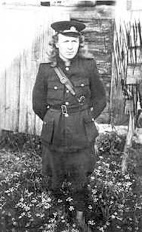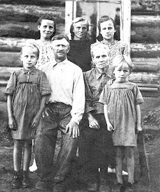While most of the partisan activity in Lithuania was over by 1953, remnants of the movement hid out across the country, with one hundred and forty-two still active in 1954, down to fifty-one in 1955.
One by one they were hunted down, and although individuals survived in hiding into the seventies, the last one shot in action was Antanas Kraujelis on March 17, 1965.

Kraujelis is on one hand a fascinating and tragic lone hero, a romantic hold-over with a lion’s mane of blonde hair, a man who managed to fight on alone long after the battle had been lost. On the other hand he is considered by some to be a murderer for the action he took against civilians.
Which version of the story are we to believe?
Born in 1928, Antanas Kraujelis was the only son of seven surviving children of a working farmer whose income was stretched to feed all the mouths in the family. Although he was good in school, as the only son, Kraujelis was needed to work on the farm.

Since he was of a patriotic nature, he became partisan courier after the war, living aboveground, but armed. The pressure was growing for farmers to join collective farms; local communist activists were coming around frequently to take away food; and the draft into the Soviet army was looming. Under these conditions, Kraujelis went underground in 1947, somewhat after the heyday of resistance.
One of his first acts was to rescue the rotting corpses of a pair of partisans who had been left out in the open to decompose as a message to potential supporters.
The families of partisans suffered for their children’s actions, and the Kraujelis parents and remaining children were deported in cattle cars to Irkutsk in 1951.
By 1952, Kraujelis’s former partisan leader, Bronius Kalytis-Siaubas, had been captured and turned and worked as a “smiter”, seeking out his former comrades to betray them to the KGB, but he never did manage to entrap Kraujelis.
(At this point in the biography of Kraujelis, it occurs to me that his story bears many similarities to the story of the main character in my novel, Underground).
Kraujelis continued to hide out, something of a Robin Hood, sometimes changing into women’s clothes to escape detection, or hiding his long hair in a military hat and dressing in a Soviet uniform to hitch rides in passing military cars. Whenever he stole from warehouses or stores, he left notes explaining that he was acting as a resister against the Soviet occupation. And he was not willing to live unnoticed – he wrote letters to Communist activists, telling them not to betray their country.
He managed to create a whole shadow life, marrying Janina Petronis and having a son with her, all the while living in a secret compartment under the fireplace of a house.
Kraujelis’s parents and family returned from Irkustk in 1959, but they were given no peace in Lithuania and his father was deported to Siberia again in 1960.
In March of 1965, Kraujelis’s place of hiding was discovered in an operation run by the infamous Nachman Dushanski, who had had a hand in the torture and execution of another famous partisan, Adolfas Ramanauskas. Sadly, the secret compartment was opened by the owner of the house, Pinkevicius, who was wounded when Kraujelis fired (Pinkevicius went on to die of his wounds).
Under gunfire, the KGB operatives fled the house. Left behind inside, Kraujelis burned documents and defended himself by firing from the windows and throwing a grenade (which did not explode). His wife, Janina, was given a letter, asking him to give himself up, but when she delivered the note to him, Kraujelis said he would not be taken alive. He bid farewell to his wife, went upstairs and shot himself.
His wife, Janina, was charged with supporting a partisan and spent four years in jail while their son was put into an orphanage. She recovered the son four years later.

Kraujelis’s father lived to see a memorial raised to his son in September of 1999. He visited as well the yard of the house he and his family had lived in during better times. The house had been bulldozed by the collective farm, but the stones of the foundation were still visible. The apple trees father and son had planted still stood as well, their branches heavy with fruit.
Now square the story above with the story on a Lithuanian web site with the headline: Lithuania Honours Partisan who Murdered 11 Civilians:
The article attacks Kraujelis’s actions up to 1952, when he killed various people, but at least one of the commentators mentions that Kraujelis was firing back at Communist activists who were firing at him.
This is the sort of split one sees often on this subject in Lithuania. The children of those executed by the partisans remember them as murderous bandits. However, sometimes they do not mention that the executed persons were carrying out the instructions of the Soviets.
I hesitate to use the word “collaborators” in this context because as Tony Judt has pointed out in Postwar (p.33), the simple notion of collaborator does not really apply to the East. Still, the people killed by Kraujelis were enemies, he perceived, of Lithuanian independence.
Such a moral mess. I hesitate to judge any of these people because I sit in a comfortable time and place. As Timothy Snyder has pointed out in his Bloodlands, we should really spend time considering the humanity of all those involved.